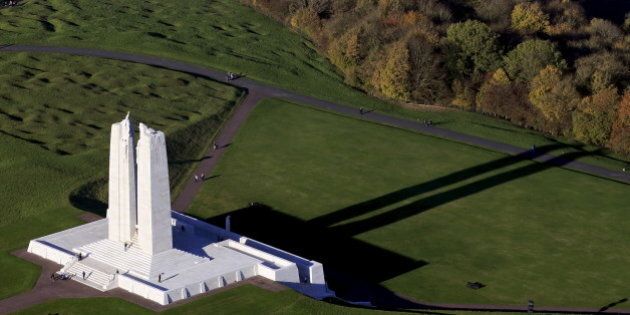
The history books told me of the Battle of Vimy Ridge. But nothing prepared me for the majesty of the Canadian National Vimy Memorial atop Hill 145. It simply took my breath away.
At first it was a spot on the horizon, poking up through early morning fog. As we drew closer, the mass of carved stone reduced us to insignificance in its presence. It is an elegant structure and seems to glow in the changing light of day.
It is impossible to describe the sense of calm I felt in the stillness of the surrounding forest. Craters large and small covered in a lush green carpet provide a most unusual undulating landscape where sheep graze. In this pastoral setting, I was left alone with my thoughts.
How does one reconcile the sacrifice of thousands of young lives and the horror of war with the jubilation of victory and the coming of age of a country?
This was my first visit to the battlefields of the Great War. I had the privilege of seeing
this site through the eyes of 19 Canadian high school students who, for their community service, bravery and leadership, received Vimy Pilgrimage Awards to travel to France and study the history of Canada's contributions. They undertook this mission to understand the legacy left by their forebears, some of them no older than they are now.
On April 9, 2016, we stood together where those before us fought so valiantly. I cannot tell you precisely what these young people were thinking, but I do know that young and old alike were profoundly moved by the experience.
We imagined the German forces looking across trenches and shell craters to the enemy lines -- at first French and British, and then in the spring of 1917, Canadian.
We marvelled at the courage and determination of those Canadian troops who pushed through the smoke of artillery fire and gas shells to take and hold the ridge. It was an offensive initially considered a lost cause by both sides.
And we read, on the Vimy Memorial that now stands there, the names of the 3,600 Canadians who died in the battle, and reflected on how their sacrifice and valour helped shape our nation.
We saw firsthand the dedicated loving care and attention given to commemoration.
We were told that Canadian success relied on innovation, from battle tactics to the wireless transmission of enemy locations from planes to gunners. It also relied on the perseverance required to withstand the harshest of conditions, and on togetherness. The esprit de corps was bolstered by all four divisions of our country's expeditionary force fighting side-by-side for the first time.
Canada was not quite 50 years old when the battle was fought. One German officer's account of the conflict states: "Deployed against us were four of the best English attack divisions -- the Canadians."
He wasn't far wrong: Canadians at the time were still considered British subjects. Our country flew the Union Flag, and yet soldiers wore the maple leaf on their uniforms. Some carved it into the tunnels under the ridge, making their mark for future generations. They identified with their fellow soldiers and with the country that they represented, which was just coming into its own on the international stage.
As Canada approaches its 150th anniversary, and the battle its 100th, it is an important moment to contemplate the values we want to uphold, and the role we wish to play in the world.
The Vimy Memorial, designed by Toronto's Walter Allard, can help us focus. Its towering pylons, topped by the figure of Peace holding a torch, are awe-inspiring and sombre. And on the corners of the wall at its base are two sets of statues.
The first, Breaking the Sword, shows two figures standing proudly on guard while another bends to destroy a weapon of war. We have long been prepared to fight for our values, but our fighting itself does not define us; instead, it is our commitment to good government and democracy.
We reject the forces of hatred and intolerance. And we do this as we are reminded by the second set of statues, Sympathy of the Canadians for the Helpless, through our inclusive and generous society.
When the memorial was unveiled in 1936, Minister of Justice Ernest Lapointe spoke of how "in their hour of testing the souls of Canadians revealed themselves gloriously at the summit of their national ascendancy." Prime Minister William Lyon Mackenzie King called Vimy Ridge "one of Earth's altars, on which Canadians sacrificed for the cause of humanity."
As we inscribe the fallen soldiers' names in our collective memory, we are reminded of the values that define us as a country. I, for one, will certainly reflect on those who served and believed in Canada's future.
Follow HuffPost Canada Blogs on Facebook
MORE ON HUFFPOST: